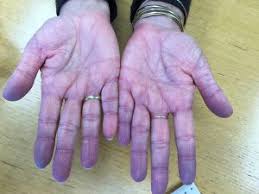Cyanosis is a medical condition characterized by a bluish or purplish discoloration of the skin, lips, nail beds, and mucous membranes. This discoloration occurs due to insufficient oxygen levels in the blood or poor blood circulation. Cyanosis is not a disease itself but rather a symptom of an underlying health issue. Understanding cyanosis, its causes, types, and treatments is crucial for timely diagnosis and effective management. In this comprehensive guide, we will explore everything you need to know about cyanosis.
What Is Cyanosis?
Cyanosis occurs when the blood circulating through the body lacks adequate oxygen. Oxygen-rich blood is bright red, while oxygen-poor blood appears darker, giving the skin and mucous membranes a bluish tint. This condition can affect localized areas, such as the fingers or toes, or it can be more widespread, affecting larger areas of the body.
Cyanosis is often a sign of an underlying problem with the heart, lungs, or circulatory system. It can occur in people of all ages, from newborns to older adults. Recognizing Cyanosis early is essential, as it may indicate a serious medical condition that requires immediate attention.
What Causes Cyanosis?
Cyanosis is caused by a lack of oxygen in the blood, a condition known as hypoxemia. Several factors can contribute to hypoxemia, including:
- Respiratory Disorders: Conditions that impair lung function, such as pneumonia, chronic obstructive pulmonary disease (COPD), asthma, or pulmonary embolism, can reduce oxygen levels in the blood.
- Cardiovascular Issues: Heart defects, heart failure, or other circulatory problems can prevent blood from being properly oxygenated. Congenital heart defects, such as tetralogy of Fallot, are common causes of cyanosis in infants.
- Cold Exposure: Prolonged exposure to cold temperatures can cause vasoconstriction (narrowing of blood vessels), leading to reduced blood flow and temporary cyanosis in the extremities.
- High Altitude: At high altitudes, the air contains less oxygen, which can lead to cyanosis in individuals who are not acclimatized.
- Methemoglobinemia: This rare condition occurs when an abnormal form of hemoglobin (methemoglobin) builds up in the blood, reducing its ability to carry oxygen.
- Peripheral Vascular Disease: Conditions that affect blood flow to the limbs, such as Raynaud’s disease, can cause localized cyanosis.
- Carbon Monoxide Poisoning: Inhaling carbon monoxide can prevent oxygen from binding to hemoglobin, leading to cyanosis.
Types of Cyanosis
Cyanosis is broadly classified into two main types: central cyanosis and peripheral cyanosis. Each type has distinct characteristics and underlying causes.
1. Central Cyanosis
Central cyanosis occurs when there is a systemic lack of oxygen in the blood. It affects the entire body, including the lips, tongue, and trunk. Common causes of central cyanosis include:
- Severe lung diseases (e.g., pneumonia, COPD)
- Congenital heart defects
- Heart failure
- High-altitude sickness
Central cyanosis is often more serious than peripheral cyanosis and requires prompt medical attention.
2. Peripheral Cyanosis
Peripheral cyanosis is localized to the extremities, such as the fingers, toes, hands, and feet. It occurs when blood flow to these areas is reduced, often due to cold exposure or circulatory problems. Common causes of peripheral cyanosis include:
- Raynaud’s disease
- Peripheral artery disease
- Hypothermia
- Venous insufficiency
Peripheral cyanosis is usually less severe than central cyanosis but can still indicate an underlying issue that needs to be addressed.
Symptoms Associated with Cyanosis
In addition to the characteristic bluish discoloration, cyanosis may be accompanied by other symptoms, depending on the underlying cause. These symptoms may include:
- Shortness of breath
- Rapid breathing (tachypnea)
- Chest pain
- Fatigue
- Dizziness or lightheadedness
- Swelling in the extremities (edema)
- Clubbing of the fingers or toes (in chronic cases)
If you or someone else experiences cyanosis along with severe symptoms like difficulty breathing or chest pain, seek emergency medical care immediately.
Diagnosing Cyanosis
Diagnosing cyanosis involves identifying the underlying cause of the oxygen deficiency. A healthcare provider will typically perform the following steps:
- Medical History: The doctor will ask about symptoms, medical history, and any recent exposure to cold or high altitudes.
- Physical Examination: The provider will examine the skin, lips, and nails for bluish discoloration and check for other signs of respiratory or cardiovascular issues.
- Pulse Oximetry: This non-invasive test measures the oxygen saturation level in the blood. A reading below 90% indicates hypoxemia.
- Arterial Blood Gas (ABG) Test: This test measures oxygen and carbon dioxide levels in the blood, providing more detailed information about lung function.
- Imaging Tests: Chest X-rays, CT scans, or echocardiograms may be used to assess the heart and lungs for abnormalities.
- Blood Tests: These can help detect conditions like methemoglobinemia or carbon monoxide poisoning.
Treatment Options for Cyanosis
The treatment for cyanosis depends on the underlying cause. The primary goal is to restore adequate oxygen levels in the blood and address any contributing factors. Treatment options may include:
1. Oxygen Therapy
Oxygen therapy is the most common treatment for cyanosis caused by low oxygen levels. It involves delivering supplemental oxygen through a mask or nasal cannula. This therapy is often used for patients with respiratory conditions like COPD or pneumonia.
2. Medications
- Bronchodilators: These medications help open the airways in patients with asthma or COPD.
- Antibiotics: If cyanosis is caused by a bacterial infection like pneumonia, antibiotics may be prescribed.
- Diuretics: These drugs help reduce fluid buildup in patients with heart failure.
- Vasodilators: These medications improve blood flow in patients with peripheral vascular disease.
3. Surgical Interventions
- Heart Surgery: Patients with congenital heart defects or severe heart failure may require surgery to correct the problem.
- Lung Surgery: In cases of severe lung disease, surgical intervention may be necessary.
4. Lifestyle Changes
- Smoking Cessation: Quitting smoking can improve lung function and reduce the risk of respiratory conditions.
- Exercise: Regular physical activity can improve cardiovascular health and circulation.
- Avoiding Cold Exposure: Keeping warm can prevent peripheral cyanosis in individuals with Raynaud’s disease.
5. Treating Underlying Conditions
Managing chronic conditions like diabetes, hypertension, or high cholesterol can help prevent complications that lead to cyanosis.
Preventing Cyanosis
While not all cases of cyanosis can be prevented, certain measures can reduce the risk:
- Maintain a Healthy Lifestyle: Eat a balanced diet, exercise regularly, and avoid smoking.
- Monitor Chronic Conditions: Keep conditions like asthma, diabetes, and heart disease under control with regular check-ups and medication.
- Avoid Extreme Cold: Dress warmly in cold weather to prevent peripheral cyanosis.
- Acclimatize to High Altitudes: Gradually adjust to high altitudes to avoid altitude sickness.
When to See a Doctor
Cyanosis can be a sign of a serious medical condition, especially if it is accompanied by symptoms like shortness of breath, chest pain, or confusion. Seek immediate medical attention if:
- Cyanosis appears suddenly.
- It affects a large area of the body.
- You experience difficulty breathing or chest pain.
- Cyanosis occurs in a newborn or infant.
Conclusion
Cyanosis is a visible sign that the body is not receiving enough oxygen. While it can be alarming, understanding its causes, types, and treatment options can help you take the necessary steps to address the underlying issue. Whether it’s a respiratory condition, a heart defect, or exposure to cold, timely diagnosis and treatment are key to managing cyanosis effectively. If you or a loved one experiences cyanosis, don’t hesitate to consult a healthcare professional for a thorough evaluation and appropriate care. By staying informed and proactive, you can protect your health and well-being.



